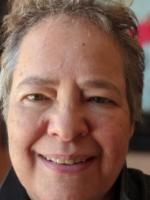

Creative Coding and Paper Circuits in the Dual Language Classroom |
Explore and create : Creation lab
Susan Brown Chava Cohen Eyal Cohen Lev Cohen Shoshanna Cohen Imani Toomer Takia Toomer
Using free online resources accessible to ages 8-108, we'll build and code circuits, illuminating artworks using LEDs. Language-acquisition design strategies that build bridges between linguistic, cultural and individual identities will demonstrate how all students can create their own paper circuits while building academic vocabulary.
| Audience: | Library media specialists, Professional developers, Teacher education/higher ed faculty |
| Skill level: | Beginner |
| Attendee devices: | Devices required |
| Attendee device specification: | Smartphone: Android, iOS, Windows Laptop: Chromebook, Mac, PC Tablet: Android, iOS, Windows |
| Participant accounts, software and other materials: | USB C to 3.5mm Headphone Adapter |
| Topic: | Maker activities & programs |
| Grade level: | PK-12 |
| Subject area: | Computer science, Social studies |
| ISTE Standards: | For Students: Innovative Designer
Facilitator
|
| Additional detail: | Student presentation |
| Disclosure: | The submitter of this session has been supported by a company whose product is being included in the session |
Students will be able to:
-Use circuit design software to create a parallel circuit, then attach the circuit to a microcontroller designed for use on paper.
-Use the Microsoft MakeCode programming environment to program and control actions of their chosen outputs.
-Make their own hand-made programmed circuit to enhance a story of their own creation.
Teachers will be able to:
-Use their hands-on experience to integrate student artworks, interactive art techniques, and computational thinking into dual-language programs as well as grade 2-12 classrooms across content areas.
-Access and use free resources to support “Tangible, Low Threshold, Low Cost Entry to Computational Thinking”
-Use Language Acquisition strategies that can help support all students as they learn about and create their own circuitry projects out of common items.
10 minutes: Introduction - Slide decks: "We are all immigrants" and "Paper Circuits and Language Acquisition Design (LAD) Strategies"
10 minutes Hands-on and device based
-Explain Language Acquisition template and have participants add their own description of vocabulary.
15 minutes: : Hands-on and device based
-Build a Parallel circuit
20 Minutes: Hands-on and device based
-Circuit Design Software: Demo (Spanish and English)
-Add Language Acquisition vocabulary
-Import an image
-Draw circuit
-Save and email to education@chibitronics.com
15 minutes: Hands-on and device based
-Attach chibi chip to sound and power
-Add Language Acquisition vocabulary
-Navigate to Makecode.chibitronics.com
-Download blink
-Apply to drawing
-Save and share link to doc called iste22papercircuits
or tweet #ISTE22papercircuits
15 minutes:
-Resource page
-Questions Parking lot (Digital parking) Save and tweet #ISTE22papercircuits
Brown, Susan, et al. Makers in Schools: Entering the Fourth Industrial Revolution. 1 ed., Alexandria, VA, Edumatch.org, 2018.
Collier, Virginia & Thomas, Wayne. (2004). The Astounding Effectiveness of Dual Language Education for All. NABE Journal of Research and Practice
Lee, V.R., Recker, M. Paper Circuits: A Tangible, Low Threshold, Low Cost Entry to Computational Thinking. TechTrends 62, 197–203 (2018).
https://doi.org/10.1007/s11528-017-0248-3
Mellis, D. et al. “Microcontrollers as Material Crafting Circuits with Paper.” MIT Media Lab, 2018, http://technolojie.com/wp-content/uploads/2019/01/2013-
Mellis-TEI-microcontrollers.pdf. Accessed 25 9 2021
Molina, R. Critical Components of Successful Dual Language Programs Association of Two-Way & Dual Language. Critical Components of Successful Dual Language Programs: Research & Implications for Practice. PDF. https://www.cosa.k12.or.us/sites/default/files/images/rosa_molina_pre-conference_final.pdf
Qi, Jie. “Paper Electronics: Circuits on Paper for Learning and Self-Expression.” Paper Electronics : Circuits on Paper for Learning and Self-Expression, Massachusetts Institute of Technology, Massachusetts Institute of Technology, 2016, https://dspace.mit.edu/handle/1721.1/109617?show=full. Accessed 26 Sept. 2021.
Sanchez, Isabella. “Project GLAD: So Much More to Learn.” NewAmerica, https://www.newamerica.org/, 21 June 2015, https://www.newamerica.org/education-policy/edcentral/project-glad/. Accessed 25 09 2021.
Tofel-Grehl, Colby, et al. ``Crafting Circuits Integrating culturally responsive teaching and current events into science.” NSTA National Science Teaching Association, NSTA, 3 2021, https://www.nsta.org/science-and-children/science-and-children-marchapril-2021/crafting-circuits. Accessed 28 9 2021
Vierstra, Gretchen. “Bridging Content & Language: Strategies from a Dual Language Classroom / by.” Teaching Channel, 15 September 2017, https://www.teachingchannel.com/blog/strategies-dual-language-classroom. Accessed 25 September 2021.

Co-author and co-editor of “Makers in Schools: Entering the Fourth Industrial Revolution” published by Edumatch, Susan has previously facilitated workshops featuring hands-on, constructivist activities at ISTE conferences and other National and Regional Conferences on this topic and on Arts Integration, STEAM, and Technology Integration. Certified to teach K-8, Masters of Instructional Technology, and Admin Certification, L. Susan Brown believes that her youth spent as a 4-Her was a major influence on her hands-on, project/problem-based perspective, and that hands-on, constructivist experience from PK-12 is at least half of a well-rounded education.




Hi! I am a 16th year educator! I have taught as an elementary science specialist, dual language classroom teacher on both the Spanish and English sides of the classroom, as a project based learning instructional coach, as a guided reading specialist, and as an elementary S.T.E.A.M. Specialist. I have also written published curriculum for multiple organizations. My passion is to help educators find the best hands on, interdisciplinary curriculum and projects to ignite the curiosity and creativity in their students regardless of funding possibilities.

